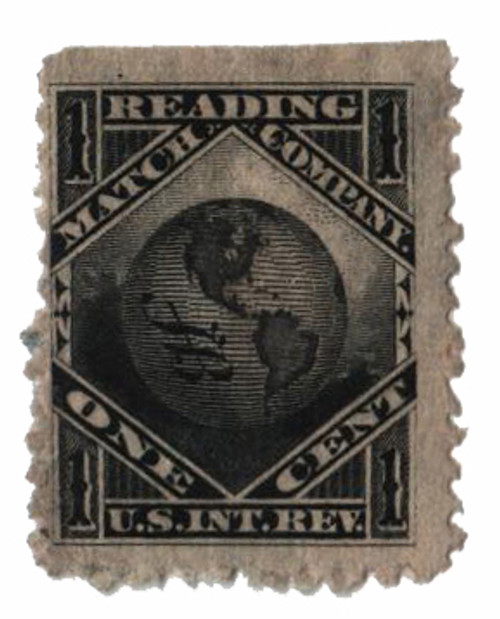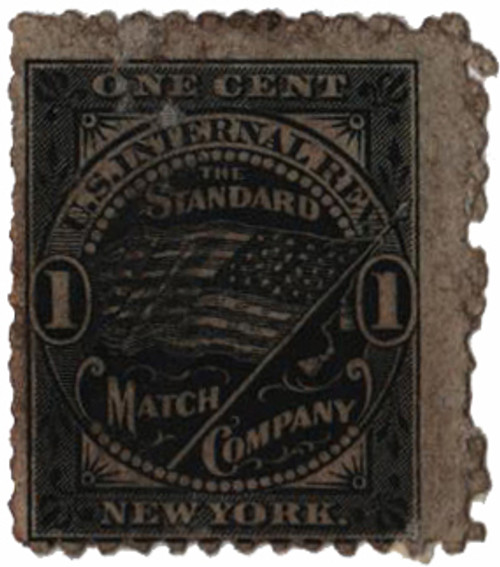
# RO164d - 1878-83 Proprietary Match Stamp - Ryder, Crouse & Welch, lake, watermark 191R
US #RO164d
1881-82 R.C. & W. Private Die Match Tax Stamp
• Covered the Proprietary Tax rate for matches
• Produced by Ryder, Crouse & Welch of Syracuse, New York
• Printed on double line watermarked paper
• Hard to find well centered and without faults
Stamp Category: Private Die Proprietary Tax Stamp
Company Using the Die: Ryder, Crouse & Welch of Syracuse, New York
Value: 1¢ Match Tax
First Day of Issue: First issued December 1, 1881, last issued June 24, 1882
Quantity Issued: 2,100,000
Printing Method: Engraved
Color: Lake
Watermark: Double line “USIR” (Watermark 191R – in use on Revenue stamps from 1878-1958)
Why the stamp was issued: To cover the 1¢ tax required to be paid on matches.
About the stamp design: Printed with lake colored ink. Pictures six American flags, three on either side of a stars and stripes shield that has a flying eagle attacked to the center top. Text on the stamp reads “One Cent,” “Match Stamp,” “U.S. Inter. Rev.,” R.C. & W. Syracuse NY.”
Special design details: On double line “USIR” watermarked paper of the type 191R which was in use on US Revenue stamps from 1878 to 1958. According to the Scott Specialized Catalogue of United States Stamps & Covers, the watermark “is known in two different orientations: a ‘backward-stepping’ version in which each row of letters begins one letter to the left of the row above, and a second variety, called a ‘forward-stepping’ variety, in which each row of letters begins one letter to the right of the row above.”
History the stamp represents: The United States issued its first Revenue stamps in 1862 to help fund the Civil War (although the stamps continued to be issued long after the war ended). This included Proprietary Tax stamps covering taxes on medicines, matches, perfumes, and much more. The taxes required for each different type of item were laid out in Schedule C of the 1862 Tax Act.
Later on, the federal government began offering tax discounts to manufacturers who produced their own Proprietary Tax stamps. The manufacturers paid for the engraving and printing expenses while the printing dies were controlled and approved by the US Department of the Treasury. Since each individual company determined the design of their stamps, they often used them as miniature advertisements for their products.
There is little information known about Ryder, Crouse & Welch today, only that they were located in Syracuse, NY, needed Match Tax stamps, and were run by Nehemiah Ryder, Charles Crouse, and Michael Welch. Just over 2 million of the stamps were printed. With many likely destroyed through use, the quantity remaining for collectors is low, making it scarcer today – especially well-centered examples without faults.
US #RO164d
1881-82 R.C. & W. Private Die Match Tax Stamp
• Covered the Proprietary Tax rate for matches
• Produced by Ryder, Crouse & Welch of Syracuse, New York
• Printed on double line watermarked paper
• Hard to find well centered and without faults
Stamp Category: Private Die Proprietary Tax Stamp
Company Using the Die: Ryder, Crouse & Welch of Syracuse, New York
Value: 1¢ Match Tax
First Day of Issue: First issued December 1, 1881, last issued June 24, 1882
Quantity Issued: 2,100,000
Printing Method: Engraved
Color: Lake
Watermark: Double line “USIR” (Watermark 191R – in use on Revenue stamps from 1878-1958)
Why the stamp was issued: To cover the 1¢ tax required to be paid on matches.
About the stamp design: Printed with lake colored ink. Pictures six American flags, three on either side of a stars and stripes shield that has a flying eagle attacked to the center top. Text on the stamp reads “One Cent,” “Match Stamp,” “U.S. Inter. Rev.,” R.C. & W. Syracuse NY.”
Special design details: On double line “USIR” watermarked paper of the type 191R which was in use on US Revenue stamps from 1878 to 1958. According to the Scott Specialized Catalogue of United States Stamps & Covers, the watermark “is known in two different orientations: a ‘backward-stepping’ version in which each row of letters begins one letter to the left of the row above, and a second variety, called a ‘forward-stepping’ variety, in which each row of letters begins one letter to the right of the row above.”
History the stamp represents: The United States issued its first Revenue stamps in 1862 to help fund the Civil War (although the stamps continued to be issued long after the war ended). This included Proprietary Tax stamps covering taxes on medicines, matches, perfumes, and much more. The taxes required for each different type of item were laid out in Schedule C of the 1862 Tax Act.
Later on, the federal government began offering tax discounts to manufacturers who produced their own Proprietary Tax stamps. The manufacturers paid for the engraving and printing expenses while the printing dies were controlled and approved by the US Department of the Treasury. Since each individual company determined the design of their stamps, they often used them as miniature advertisements for their products.
There is little information known about Ryder, Crouse & Welch today, only that they were located in Syracuse, NY, needed Match Tax stamps, and were run by Nehemiah Ryder, Charles Crouse, and Michael Welch. Just over 2 million of the stamps were printed. With many likely destroyed through use, the quantity remaining for collectors is low, making it scarcer today – especially well-centered examples without faults.












